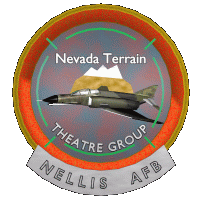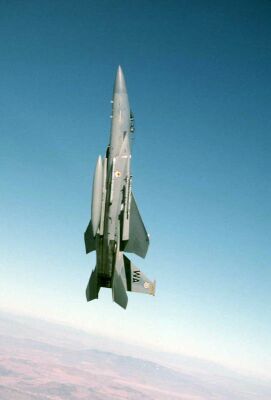

optimized airplane, the designation for the project was F-X.
The main requirement was to use the same configuration of armament as the F-4 Phantom.
The result was the F-15A Eagle, an incredible advance in all aspects of military jet planes,
the fuel capacity and his APG-63 were exceptional, it had HOTAS and HUD, new concepts
in that time and the structure was designed to support more g�s.
When it started to be received by the squadrons in 1974 it demonstrated a superior capacity
of combat than the F-4E Phantom, the main plane of the USAF in that time.
The F-15A quickly was exported, countries as Israel received them in 1976 which entered
in action in 1982 against Syria in the valley of Bekaa shooting down 40 planes without any
lost.
The development of the F-15 continued after 1980 making the F-15C/D which was firstly
deployed at Germany and Okinawa, it incorporated new features like an additional
capacity of fuel and more g resistance.
The F-15C was exported to Israel and Arabia Saudi, which used them to destroy two
Iranian F-4 Phantom II during the Irak-Iran war.
The F-15 was the plane which shoot down more planes during the Gulf War, without any
lost.
The main characteristic of the F-15 is his superior wing surface which gives to it a very
good agility at high altitude, the pilots say that planes like the F-4E Phantom lose all of his
�energy� before the pilot himself, you go into a 7g turn and the velocity comes down fast,
but in the F-15..., instead of that you can go to a high angle of attack turn and all you get is
an, �oh, im tired�, no stalls and things like that.
Another curious thing is that you can start at sea level with the half of fuel and you pull at
7g�s, it doesn�t stop until you reach 18000 feet.
Some time ago, a lightened F-15 known as Streak Eagle beat many records, taking off at
Mach 0.65, after 56 seconds Mach 1.1 and 32000 feet, 151 seconds Mach 2.2, 37000 feet and
finally 98425 feet Mach 0.7 in 207 seconds.
A big difference between the F-16 and the F-15 is that the F-15 doesn�t use the electric
flight by wire system, it has it and the pilots can turn it on whenever they want, in the F-16
if your computer dies you are lost, it can die for many reasons, for example an
electromagnetic pulse.
Its cockpit is one of the biggest, almost like the F-105 Thunderchief but with the
instruments better distributed and there�s enough space room in the back so you can put a
couple of bags when you go from one base to another.
Actually the F-15 is deployed at many fighter wings being the most powerful plane in
service with the USAF until the F-22, his successor, enter in service this decade.
Dimensions
Longitude: 16.26m
Heigh: 4.47m
Wing Span:17.53m
Engine
Two General Electric RF34-GE-100, 40.32Kn
Fuel
Internal fuel: 4853 kg
External fuel: Three fuel tanks of 2271 l
Armament
Gun: GAU-8A of 30mm with 1350 shells
External load: 7260 kg (GBU�s, CBU�s, Rockets, Mavericks)
Performance
Maximum horizontal speed at sea level: 700 km/h
Maximum speed at 1525m: 630 km/h
Climb rate: 1800 m/minute
Take off run: 1220m at full load or 442m at airstrip
Landing run: 610m at full landing weight or 336m at airstrip